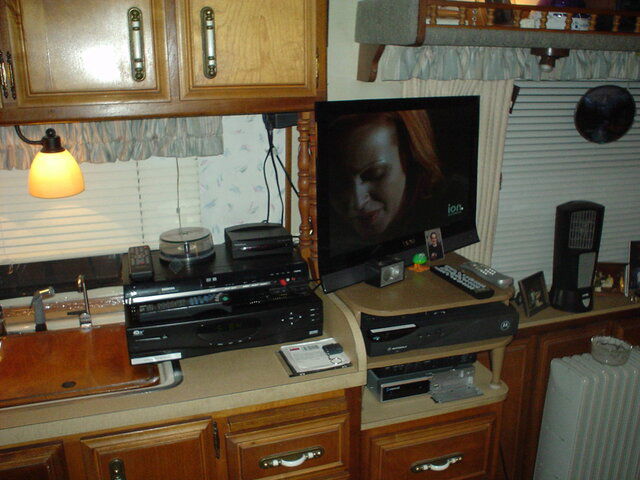I'll try not to bore anyone as I ask for advice and help with an FTA positioner situation.
I'm living in a small space by choice.... (some of the time, that is... I have a permanent address at a great distance away from my business...that remains for sale. I hope it sells soon.) Warm in the winter, cool in the summer, and quite roomy for what one would think! Except where room for home entertainment equipment is concerned.
Connected to my space are (2) separate Birdview dishes. One is not set up to move, it brings me W-5 subs through the DSR-410 box. Happily and easily.
The other dish was my 4DTV setup, slaved to FTA, now dedicated FTA. Here's the problem. Space. The frontier I don't have on my counter.
I've tried two alternatives to driving my birdview with the 4D. Both the G-box and the V-box units fit better physically but error-out immediately when trying to read pulses. Not due to "overload" (that's a different error) but because of the RF radiated by 3 towers of AM (and 212 watts of FM) in my back yard. Pulses coming back are regular and verified.
The only difference I can see between the V-Box/G-box and my 4D being used as a positioner successfully is that the 4DTV unit is heavily shielded with a metal cage, and...when we changed its battery, we noted a HEAVY, LARGE RF "toroid" coil on the mover's wires just before they reach the terminals on the back of the unit.
I believe that a heavily shielded (smaller footprint) positioner would work in place of the 4D unit, given that the 4d moves the dish flawlessly, and two others do not. This rules out any issue with the reed switch, wiring, or dish setup. My question is this:
Has anyone taken apart a G-box/V-box and could they be equally shielded? or....better yet, (here's the part I'm really curious about) could an older General Instrument positioner 350ips unit do the job? I don't know much about these, can't find any manuals online, but it appears to be a "stand alone" positioner that may just use simple front panel numbers and East-West commands. (no interfacing with the FTA receiver, but a good, reliable, heavy duty power supply, probably well shielded, and....compatible with a standard pulse-return/36 volt system.
Do I have the proper information on the 350 IPS? Is it a stand alone positioner? Would it work with reed-switch standard setups and operate manually?
As you can see from the photo, I'm a bit "space challenged" and want to clean up the setup a bit.
Any help, suggestions, ideas welcomed! For now, my 4DTV is a (very large) dish mover only. It didn't like the "work around" anyway for subs, and I've got a 410 for that, so it can move the dish til a suitable replacement is found.
-radio
I'm living in a small space by choice.... (some of the time, that is... I have a permanent address at a great distance away from my business...that remains for sale. I hope it sells soon.) Warm in the winter, cool in the summer, and quite roomy for what one would think! Except where room for home entertainment equipment is concerned.
Connected to my space are (2) separate Birdview dishes. One is not set up to move, it brings me W-5 subs through the DSR-410 box. Happily and easily.
The other dish was my 4DTV setup, slaved to FTA, now dedicated FTA. Here's the problem. Space. The frontier I don't have on my counter.
I've tried two alternatives to driving my birdview with the 4D. Both the G-box and the V-box units fit better physically but error-out immediately when trying to read pulses. Not due to "overload" (that's a different error) but because of the RF radiated by 3 towers of AM (and 212 watts of FM) in my back yard. Pulses coming back are regular and verified.
The only difference I can see between the V-Box/G-box and my 4D being used as a positioner successfully is that the 4DTV unit is heavily shielded with a metal cage, and...when we changed its battery, we noted a HEAVY, LARGE RF "toroid" coil on the mover's wires just before they reach the terminals on the back of the unit.
I believe that a heavily shielded (smaller footprint) positioner would work in place of the 4D unit, given that the 4d moves the dish flawlessly, and two others do not. This rules out any issue with the reed switch, wiring, or dish setup. My question is this:
Has anyone taken apart a G-box/V-box and could they be equally shielded? or....better yet, (here's the part I'm really curious about) could an older General Instrument positioner 350ips unit do the job? I don't know much about these, can't find any manuals online, but it appears to be a "stand alone" positioner that may just use simple front panel numbers and East-West commands. (no interfacing with the FTA receiver, but a good, reliable, heavy duty power supply, probably well shielded, and....compatible with a standard pulse-return/36 volt system.
Do I have the proper information on the 350 IPS? Is it a stand alone positioner? Would it work with reed-switch standard setups and operate manually?
As you can see from the photo, I'm a bit "space challenged" and want to clean up the setup a bit.
Any help, suggestions, ideas welcomed! For now, my 4DTV is a (very large) dish mover only. It didn't like the "work around" anyway for subs, and I've got a 410 for that, so it can move the dish til a suitable replacement is found.
-radio
Attachments
Last edited:



